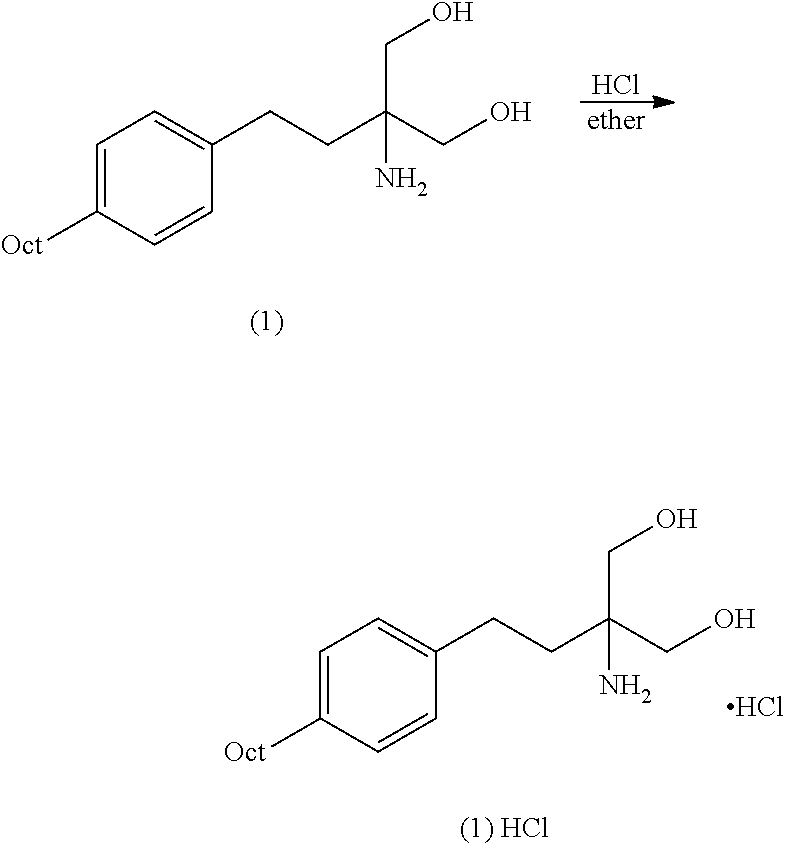Intermediate compounds and process for the preparation of fingolimod
a technology of intermediate compounds and fingolimod, which is applied in the preparation of amino compounds, group 5/15 element organic compounds, drug compositions, etc., can solve the problems of no marketed treatment for ms can produce remyelination, contain many complicated steps, and large quantities of organic solvents
- Summary
- Abstract
- Description
- Claims
- Application Information
AI Technical Summary
Benefits of technology
Problems solved by technology
Method used
Image
Examples
examples 1-5
Example 1
Preparation of 3-nitro-1-(4-octylphenyl)propan-1-one (12)
[0160]In a dry flask, 3-nitropropanoic acid [available commercially or prepared according to Silva, P. C.; Costa, J. S.; Pereira, V. L. P. Synth. Commun. 2001, 31, 595, (10.0 g, 85.0 mmol) was stirred overnight with SOCl2 (100 ml). Following addition of anhydrous toluene, the solution was azeotropically distilled to remove excess SOCl2. The residue can be used directly for acylation or distilled (80-83° C. / 0.1-0.2 mbar [SYNTHESIS 2009, No. 5, p. 715]) to afford pure 3-nitropropanoyl chloride as a clear liquid.
[0161]AlCl3 (12.0 g, 89.0 mmol) was added to 15 ml of methylene chloride and cooled to 0-5° C., following by addition of 3-nitropropanoyl chloride (11 g, 80 mmol). Octylbenzene (17.10 g, 89.0 mmol) in 40 ml of CH2Cl2 was dropwise added and the solution was stirred at room temperature under TLC monitoring. After reaction completion, the mixture was poured onto ice, acidified by addition of 2 M HCl to pH 2, and ext...
example 2
Preparation of 3-nitro-1-(4-octylphenyl)propyl acetate (13)
[0162]To a solution of 3-nitro-1-(4-octylphenyl)propan-1-one (12) (5.00 g) in methanol (25 ml) was added sodium borohydride (0.8 g) at 0° C. and the mixture was left at room temperature for 4.5 hr. The suspension was diluted with ethyl acetate and washed successively with 1 N HCl, sodium bicarbonate solution and brine. The ethyl acetate layer was dried over anhydrous Na2SO4 and concentrated. To the residue was added pyridine (1.5 eq), dichloromethane (10 v) and acetic anhydride (10 eq), and the mixture was left at room temperature overnight. To the reaction mixture was added ice water and the mixture was extracted with ethyl acetate and washed successively with 1 N HCl, sodium bicarbonate solution and brine. The ethyl acetate solution was dried over sodium sulfate and concentrated. The residue was pure enough for transformation to the next step or can be purified by silica gel column chromatography using hexane-ethyl acetate...
example 3
Preparation of 2-nitro-2-[2-(4-octylphenyl)ethyl]propane-1,3-diol (14)
[0163]To a mixture of paraformaldehyde (0.13 mol, 9 eq), 4 ml (1.5 eq) of triethylamine in 40 ml of 1,4-dioxane, 3-nitro-1-(4-octylphenyl)propyl acetate (13) (5 g, 0.015 mol) in 50 ml of 1,4-dioxane was added dropwise with stirring at RT, the mixture was slowly heated to 70° C., and stirred for 24 h at this temperature, under TLC control. To the reaction mixture was added water and the mixture, pH adjusted to ˜9-10 and stirred 16 h at 40° C. for deprotection (TLC and HPLC monitoring). After reaction completion (˜2-3 h) the mixture was extracted with ethyl acetate and washed successively with 1 N HCl, sodium bicarbonate solution and brine. The ethyl acetate solution was dried over sodium sulfate and concentrated. The residue was pure enough for transformation to the next step or can be purified by crystallization or silica gel column chromatography using hexane-ethyl acetate as eluent to afford a white solid with m...
PUM
| Property | Measurement | Unit |
|---|---|---|
| temperature | aaaaa | aaaaa |
| temperature | aaaaa | aaaaa |
| temperature | aaaaa | aaaaa |
Abstract
Description
Claims
Application Information
 Login to View More
Login to View More - R&D
- Intellectual Property
- Life Sciences
- Materials
- Tech Scout
- Unparalleled Data Quality
- Higher Quality Content
- 60% Fewer Hallucinations
Browse by: Latest US Patents, China's latest patents, Technical Efficacy Thesaurus, Application Domain, Technology Topic, Popular Technical Reports.
© 2025 PatSnap. All rights reserved.Legal|Privacy policy|Modern Slavery Act Transparency Statement|Sitemap|About US| Contact US: help@patsnap.com



